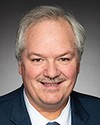Thank you for that question.
Opioid agonist therapy is about having people on a treatment that can stabilize them neurochemically, having them not chase what we talked about earlier with withdrawal and really allowing for recovery. The two main types of opioid agonist therapy are methadone, which has been around for years, and buprenorphine. Buprenorphine was not available at the time the study in London was started.
Buprenorphine is a chemical, an opioid. As to how it works, as you increase the dose, you don't get an increase in negative effect. It is the drug most proven to decrease the risk of overdose. When people are on it, they have a decreased risk of overdose from taking it and from taking other substances.
Buprenorphine now comes in a daily sublingual formulation. It also comes in an injectable formulation that is usually referred to as Sublocade, which is given every four weeks. This is a game-changer because it allows people to get their lives back and get back to the community. Not having to worry about accessing a pharmacy daily is certainly helpful in remote communities as well. It provides a healing of the brain to allow people to have recovery and function normally.
Safer supply programs are about continuing to give opioids at doses that aren't witnessed. I think it's important to recognize that when people are started on methadone and Suboxone, we check what they're able to take. We understand their tolerance. We work with them as we're witnessing what they're taking and we know what they're taking. When people are started on safe supply, that is not the case.
I'm going to be a bit more specific about my own community. A dose can continue to go up without reflection on whether it's a safe dose for a person or a safe dose for the community. It's generally given to them on a daily basis. Sometimes it's every few days. Then the dose is escalated. In my community, generally that's at request, without any evidence that it's what they need. Even when there is evidence that they don't tolerate their dose, it isn't necessarily decreased.
People will continue to have to go to a pharmacy, usually on a daily basis. It means that they're continuing to, from a neurochemical perspective, chase withdrawal. It is about continuing somebody in an addiction. They're maintaining their addiction. They're being maintained in a state where they are addicted to the medication.





